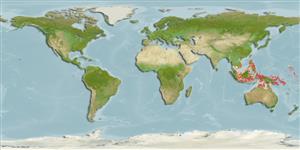Asteroidea |
Valvatida |
Ophidiasteridae
Environment: milieu / climate zone / djupintervall / distribution range
Ekologi
; djupintervall 0 - 25 m (Ref. 81020). Tropical
Indo-West Pacific.
Length at first maturity / Size / Weight / Age
Könsmognad: Lm ? range ? - ? cm
Found in waters less than 30m. Associated with coral communities. Likely feeds on turf algae and bacterial film over hard substrates (Ref. 129602).
Life cycle and mating behavior
Könsmognad | Reproduktion | Lek | Eggs | Fecundity | Larvae
Members of the class Asteroidea exhibit both asexual (regeneration and clonal) and sexual (gonochoric) means of reproduction. Life cycle: Embryos hatch into planktonic larvae and later metamorphose into pentamorous juveniles which develop into young sea stars with stubby arms.
Lane, D.J.W., L.M. Marsh, VandenSpiegel and F.W.E. Rowe 2000 Echinoderm fauna of the South China Sea: an inventory and analysis of distribution patterns. The Raffles Bulletin of Zoology (Suppl. 8):459-493. (Ref. 81020)
IUCN Red List Status
(Ref. 130435: Version 2025-1)
CITES status (Ref. 108899)
Not Evaluated
Not Evaluated
Threat to humans
Human uses
| FishSource |
Verktyg
Ytterligare information
Population dynamicsTillväxt
Max. ages / sizes
Length-weight rel.
Length-length rel.
Length-frequencies
Mass conversion
Abundans
PhysiologySyreförbrukning
Human RelatedStamps, coins, misc.
Internet-källor
Estimates based on models
Preferred temperature
(Ref.
115969): 27.8 - 29.2, mean 28.8 (based on 592 cells).
